Elizabeth Minchilli's Blog, page 16
November 5, 2018
yellow + green pasta puttanesca {dinner party}
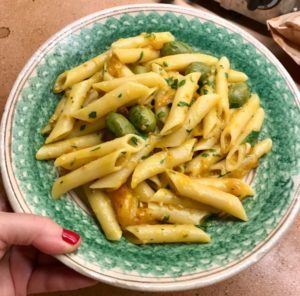
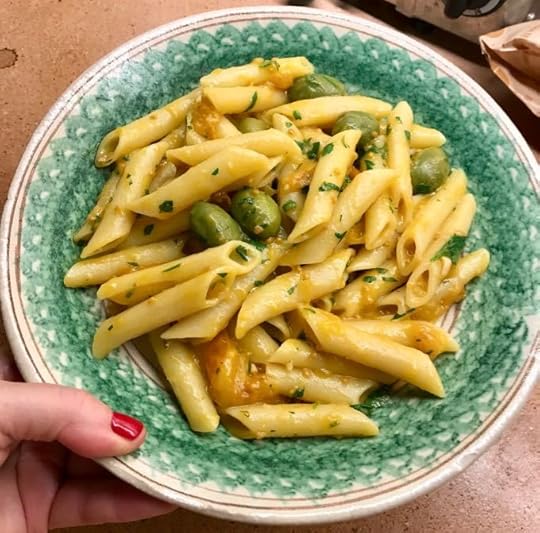
The other night up in Todi I made a last minute pasta for dinner. The ingredients were simply what I had in the panty, which I make sure to keep well stocked. I know I’m not the only one to ever sing the praises of a well stocked panty as a dinner resource. And I’m not even the first to say ‘make puttanesca’ ,a pantry staple. But here’s the thing about my pantry. A lot of times it’s stocked with goodies that are sent to me to try out. Things I not only wouldn’t find at my local market, but items that I’ve never even cooked with before.
So when I opened my jars of tomatoes they weren’t the ordinary red San Marzano pelati or even my own tomatoes I put up over the summer. They were jars of bright yellow cherry tomatoes that I had been thinking were some kind of jam in the back reaches of my shelves for about a year. Every time I would go to make a crostata I would spy these jars hiding out behind the bags of beans and cans of tuna, pull them out thinking they were orange marmalade only to find the bright yellow cherry tomatoes my friend Beatrice had given me last year. “Oh, I should use these’ I’d think, before setting them down, still in search of jam, and forgetting about them as they migrated their way back to the far reaches of my dispensa.
Until Friday when I decided to give them a spin.
I think one of the reasons that I had avoided using these tomatoes was because the only other time I had them they had been turned into a simple tomato sauce that, frankly wasn’t that impressive. The thing is with yellow tomatoes, which are grown just south of Naples in Campania, is that they are sweeter and less acidic, than their red cousins. Which is fine in theory, but for me the super simple tomato sauce I had in Grangnano was just a tad boring. It lacked zip.
Puttanesca sauce, made up of tomatoes, with capers, anchovies, olives, garlic and a hint of pepperoncino, is pure zip. (Here is a classic recipe for it).So I decided that puttanesca was the perfect opportunity to spice up the pomodorini gialli.
I ended up forgoing the capers (I didn’t have any) but did use extra garlic and some super spicy red pepper from Calabria. 8 anchovy fillets instead of the normal 4 or 5 added ample umami and briny saltiness. Which I needed because I also decided to use big fat green olives from Ceringnola instead of small black olives.
Usually for Puttanesca I use the smallest, most intense black olives I can find. The tiny ones that come from Gaeta are perfect. But instead I had the bright green orbs from Puglia, which are much less aggressive, and definitely on the fruity side.
My brilliant idea (actually it was as much due to laziness as anything else) was to leave the olives whole, instead of pitting them.. I LOVED the contrast of the bright yellow tomatoes and the big fat vivid green of the olives and thought they would look fabulous on the plate. Which they did.
My laziness extended to not taking as many photos as I should have. Sorry about that. If you follow my instagram stories then you got to see thefull recipe being made, as well as more images and videos. For now I’ll leave you with the handful of photos I took, as well as the recipe.
The rest of the meal came together simply. After our pasta course, I used lettuce just picked form the garden to make a salad with our freshly pressed olive oil, which I also drizzled on top of bruschetta toasted on the fire. For dessert I made Sky McAlpines Saffron Panna Cotta . FYI: it pairs perfectly with the Nonino Aged Chardonnay Grappa.
My friend Beatrice sells both the tomatoes as well as the olives at her site Gustiamo, and Eataly (at least in Italy) carries them as well. So if you do feel like making this, you can. And if you are craving olio nuovo after you’ve seen these bruschetta you can order directly from our friends at Montioni. Just send them an email here.
The Menu
Aperitivi:
Negronis by the fireplace and pistachios
Primo:
Yellow and Green Pasta Puttanesca (recipe below)
Secondo:
Bruschetta with Olio Nuovo
Green salad from the garden, with more olio nuovo
Dolce:
Saffron Panna Cotta (from Skye McAlpine’s A Table in Venice)
Drinks:
Negronis first, then we moved on to Chianti Classico. Nonino Aged Chardonnay Grappa paired perfectly with the Saffron Panna Cotta.
Setting the Table
Dishes: Made by Alessi in Caltigirone
Those bizarre candlesticks were bought by the man who tended one of the locks on the Canal du Midi in France. He was also a sculpture and these were the only pieces small enough to fit in my suitcase.
Glassware: All bought at the supermarket in Todi.
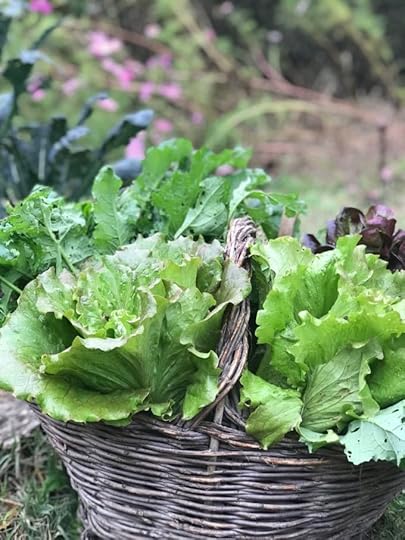
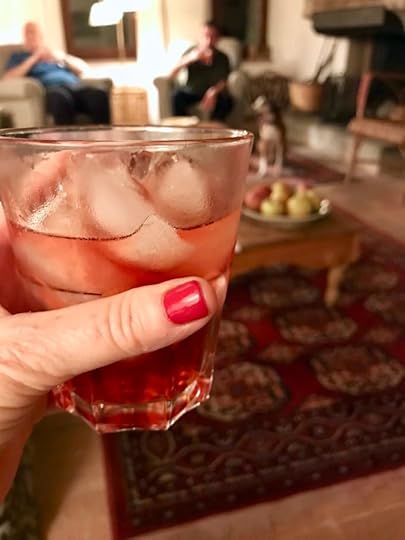
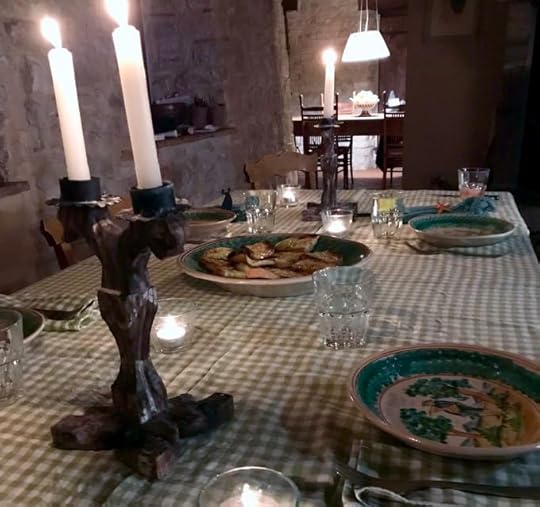
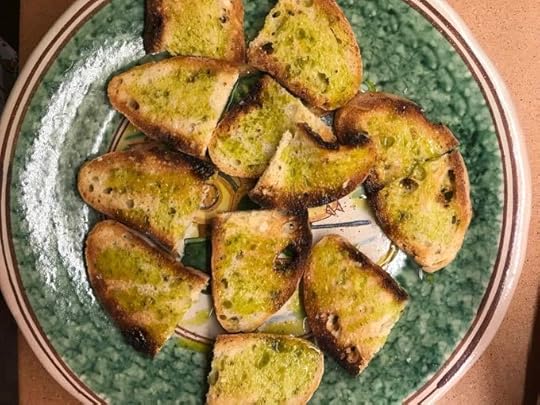
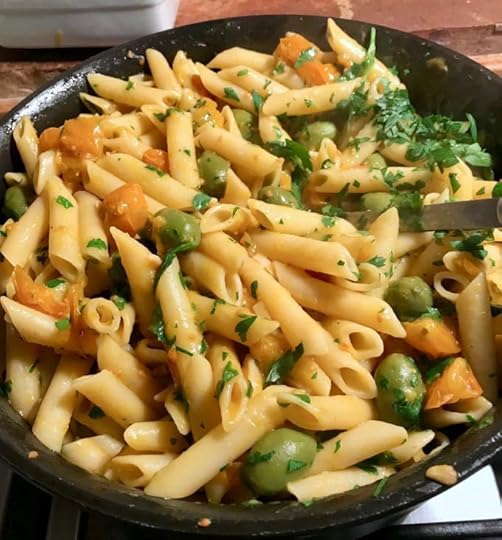
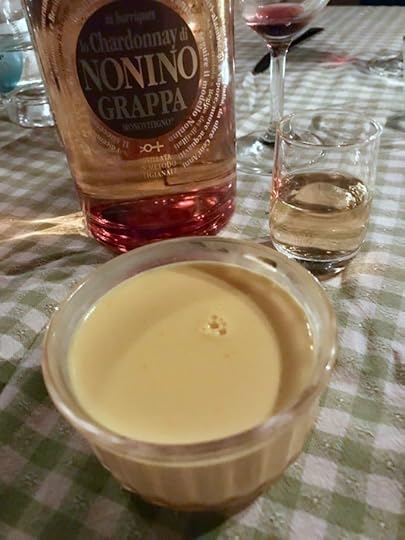
Yellow and Green Pasta Puttanesca
Ingredients
1/4 cup of olive oil
4 large cloves of garlic, chopped
1/8 tsp red pepper flakes (or to taste)
3 400 gr jars or cans of yellow cherry tomatoes
1/2 teaspoon of salt
1 1/2 cups Cerignola olives with pits
500 grams / 1 pound of pasta (I used Faella penne lisce) 1 cup chopped flat leaf parsley
Instructions
Pour the olive oil into a pan large enough to hold all of the cooked pasta later. Add the chopped garlic and the red pepper flakes and heat over medium heat just until the garlic begins to turn golden. Be careful not to let it brown.
Add the tomatoes and all of their juices and salt. Bring to a simmer and add the olives.
Let cook at a medium high heat for about 20 minutes. If the sauce seems to be reducing too fast, add a half cup of water.
In the meantime bring a large pot of salted water to boil and cook the pasta until al dente.
Drain the pasta and add to the pot with the sauce, stirring to combine. Add the parsley and stir.
Serve, making sure everyone gets some olives. Also make sure to tell people the olives still have pits!! And it’s a good idea to provide a few littles plates where people can place their discarded pits. If they put them back on their plate they may end up eating them and breaking a tooth!
In keeping with the yellow theme of the dinner I also made the recipe for Safron Panna Cotta from Sky McAlpine’s book A Table in Venice. I will never make plane old panna cotta again. I loved it’s exotic slightly savory taste and it paired perfectly with the bottle of aged Chardonnay Nonino Grappa that was also happily in my pantry.

The post yellow + green pasta puttanesca {dinner party} appeared first on Elizabeth Minchilli.


October 21, 2018
making bowtie pasta by hand {video}
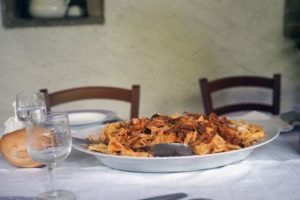
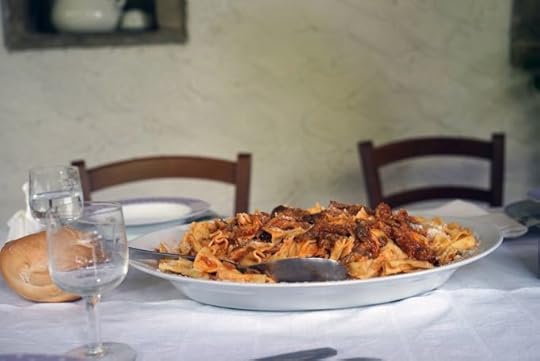
A friend of mine recently wrote a blog post asking food writers from Rome what their favorite pasta shape was, and which one they didn’t like. As someone who writes about Italian food, you can imagine that I get this kind of question a lot. And I hate it. I really don’t think talking about ‘favorite’ things helps anyone. People have personal tastes, and just because I say I like penne (it reminds me of the first plates of pasta that I had as a child in Rome) or that I don’t like buccatini (it’s too messy and difficult to eat) doesn’t mean anything for anyone else other than me. It’s just not useful or (I think) interesting information to have.
What I did find extremely amusing, and surprising, though was in the discussions on Facebook that occurred when I posted the link. First of all? People REALLY wanted to share their favorite pasta shapes. But even more than that, people couldn’t wait to say which shapes they hated. Hated? Seriously? How can you hate a pasta shape?! The world is in bad enough shape (yes, that was a pun) these days to save your strong negative emotions for something more worthy.
But the most surprising thing of all was the shape that people seemed to hate the most. Bowtie pasta. For real. People really hate this defenseless little shape. The reason most gave is that when they cook it, the little pinched part in the middle remains hard, while the wings are over-cooked and floppy.
Ok then. Haters gotta hate, I guess. Me? I’m going to go on eating, and making, bowties. Yes, making them. While working on my last two books (Eating My Way Through Italy and The Italian Table) I had the chance to hang out in several kitchens in and around Parma. During one visit to the kitchen of Elisa I learned how to make ‘galani.’ Which are bowties, or – as more commonly called in Italy ‘farfalle’ or butterflies.
How can you hate something called ‘butterfly’?!
If there is a funner shape of pasta to make, especially with kids helping you, I don’t know it. And for you haters out there? If you make your own (and avoid the industrially made packs) I think you’ll find that little center part cooks up just fine (in case you were worried).
The pasta recipe is just a straightforward flour and egg dough that you can everywhere, including here and in both of my books mentioned above.
Unfortunately the recipe for the wonderful mushroom sauce Elisa made didn’t make it into either book. So along with this video of the adorable Elisa and her husband, making equally adorable butterflies, I’m leaving you with the recipe for the mushroom ragu. Which I am giving you permission to use on the pasta shape of your choice.
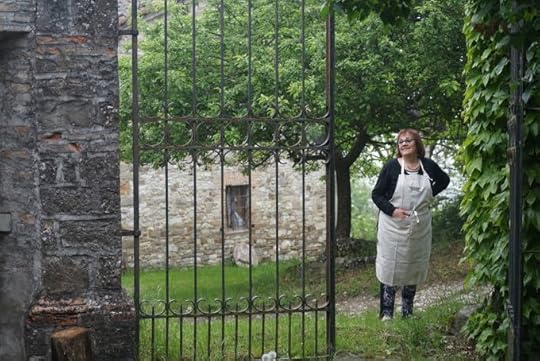
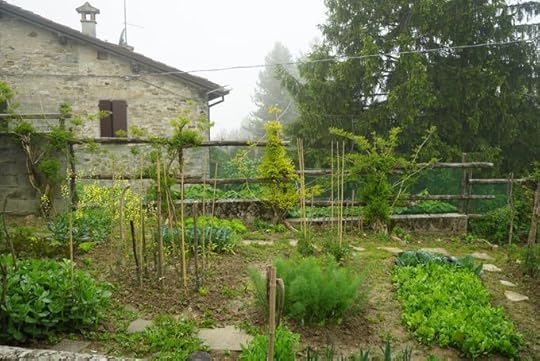
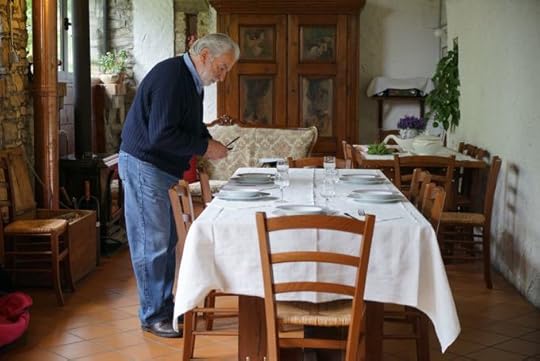
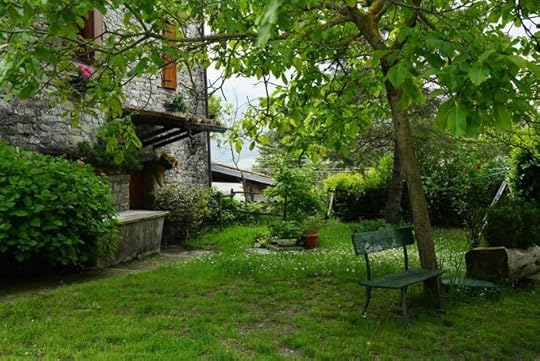
Dried Porcini Mushroom Sauce
Enough for 1/2 kilo / 1 pound of pasta
Ingredients
100 grams of dried porcini mushrooms
1 medium sized red onion, or 2 shallots
1/2 cup dry white wine
1/2 cup extra virgin olive oil
2 tablespoons of tomato paste
1 tsp of sugar
1/2 teaspoon of salt
freshly ground black pepper
Instructions
Place the dried mushrooms in a large bowl of warm water to soak for about 40 minutes.
In the meantime chop the onion finely. Pour the olive oil into a medium saute pan and turn heat to medium. Add the onions, salt and sugar and cook until the onions are beginning to turn golden.
Drain the mushrooms (reserving the soaking water). and squeeze them dry. Separate the heads of the mushrooms from the stems. Since the stems are usually a bit tough, chop them up into smaller pieces. Add both the heads and the chopped stems to the pan with the onions and let them cook for about 15 minutes.
Add the white wine and once it has evaporated, add the tomato paste, along with half a cup of the mushroom soaking water, stirring well. Cook over low heat for another 15 minutes. If it seems to dry out, add some more of the mushroom cooking water.
To serve, place some of the sauce onto a serving platter, and place the drained pasta on top. Spoon more of the sauce on top of the pasta, along with a handful of grated parmigiano reggiano. Stir gently, adding more sauce and more parmigiano, until the pasta is well and evenly coated.
More pasta recipes and other information about following your stomach through Italy is in my most recent book Eating My Way Through Italy.
For more on where to eat in Italy, please download my app Eat Italy, available for both iPhone and Android.
And if you’d like to host your own Italian meal at home, make sure you buy my next book, The Italian Table: Creating Festive Meals for Family and Friends (March 2019), available for preorder.
The post making bowtie pasta by hand {video} appeared first on Elizabeth Minchilli.


October 10, 2018
fried cheese + pears
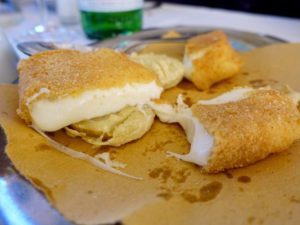
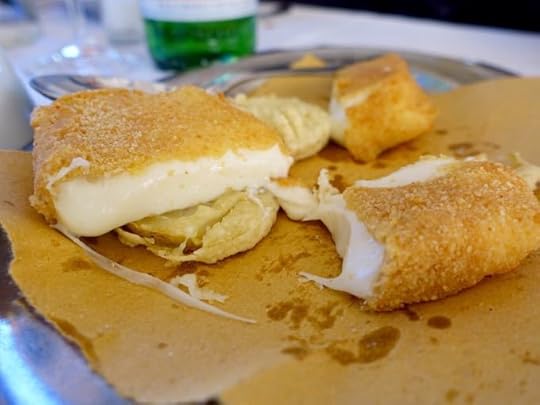
There is a saying in Italian: Al contadino non far sapere quant’e’ buono il formaggio con le pere. “Don’t let the farmer know how good cheese is with pears.” The meaning is that if the farmer knew, he would eat all the pears himself, and leave none for us. This brilliant pairing is one you see all over Italy in the fall, when pears are at their peak. It’s not really something you see on restaurant menus, but you can always ask for a perfectly ripe pear and a hunk of local pecorino. The sweetness of the pear perfectly offsets the salty farmyard taste of a mediium aged pecorino. While you can have it after a meal, my favorite time to enjoy it is as an afternoon snack. You know, that time between lunch and dinner when you get hungry but can’t quite decide on something sweet or savory?
I discovered a completely different take on this paring when I was out for the day, in the hills of Tuscany with my friend Judy. We stopped for lunch at Tullio a Montebeni and it was there that I saw the whole pear and cheese thing brought up by several hundred notches by frying not only the cheese, but the pears. Because, why not?
It makes the perfect antipasto to a fall meal. At Tullio each piece of fried cheese was served atop a round of fried pear. One thing: make sure your guests are seated before you start to fry. It only takes a few moments to cook, and you want to enjoy it while the cheese is piping hot and oozing from its crunchy fried casing.
For this recipe you need a good Pecorino Toscano, about 2 months old. In other words, you don’t want a heavily salty aged pecorino, but something a bit softer and fresher.
And while you want your pears ripe, it’s best to use one that stays a bit firm like a Bosc or a Concorde. But I’m also a firm believer in using what you have (as I did with that basket of Bartletts below).
And since you may be getting your pears from your local farmer, you have my permission to let him or her know how good this combination is (Italian saying or not).
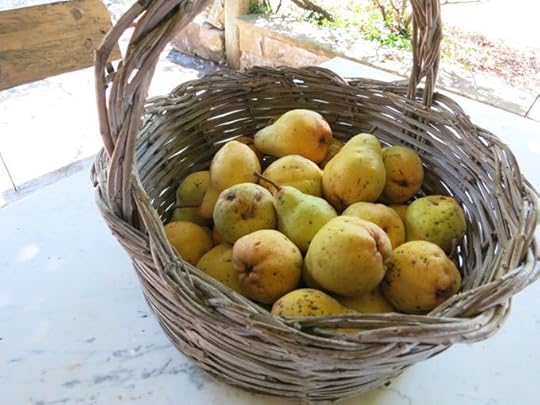
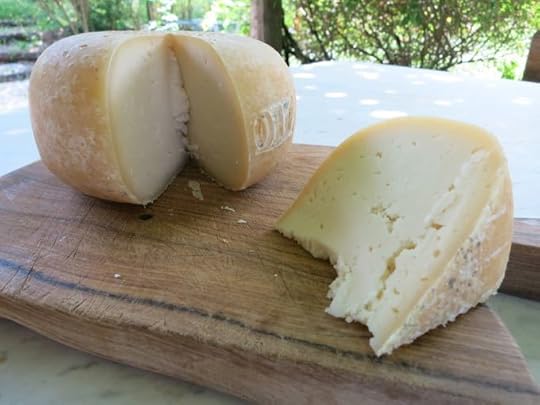
Fried Cheese and Pears
Yield 4
Ingredients
6 ounces (300 grams) fresh Pecorino Toscano
1 – 2 firm, but ripe pears
1 cup bread crumbs
2 large eggs, beaten
¼ to ½ cup all-purpose flour
Olive Oil, for frying
Instructions
Cut the cheese into ½-inch slices, trimming the rind off. Core the pear, but leave the skin on, and slice it into ½-inch wedges.
Pour the oil into a deep, heavy-bottomed pot until it comes up about 2 inches and heat over medium-high heat to about 350 to 375 F.
In the meantime, dip the cheese slices first into the egg, and then into the bread crumbs, making sure you get a good coating.
When the oil has reached temperature, gently slip the cheese into the oil, and fry them, over medium-high heat, just until the crumbs start to turn golden. Gently lift out the cheese with a slotted spoon and transfer to a paper towel–lined plate to drain.
In the meantime, add the flour to the leftover eggs. Add just enough to form a pancake-like batter. Stir well. Dip each of the pear slices into the batter, and fry in the oil for several minutes, until golden.
To serve: place the fried pears on a plate and top with the fried cheese.
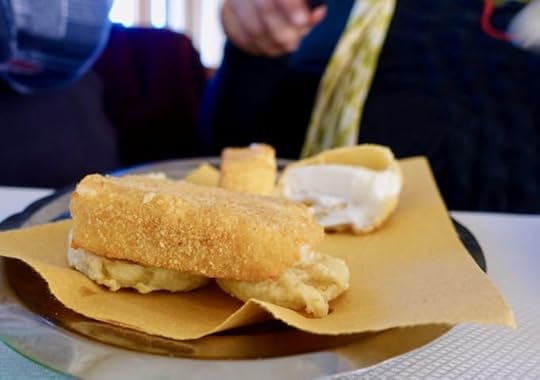
This recipe appears in my most recent book Eating My Way Through Italy.
For more on where to eat in Italy, please download my app Eat Italy, available for both iPhone and Android.
And if you’d like to host your own Italian meal at home, make sure you buy my next book, The Italian Table: Creating Festive Meals for Family and Friends (March 2019), available for preorder.
The post fried cheese + pears appeared first on Elizabeth Minchilli.


September 24, 2018
AFAR Magazine Joins us in Umbria
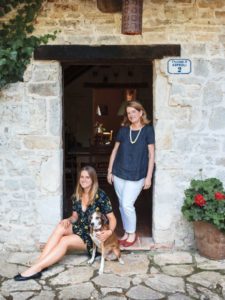

photo Federico Ciamei
As most of you know, I’ve been calling Umbria home for about 30 years. I’ve written about it countless times, in magazines and books, and of course on this blog and all over social media. (I hope you’re not getting sick of it!).
A year ago I also started bringing guests there, on the Week in Umbria tours that Sophie and I lead. On the very first week we did we had the great pleasure to host a friend and colleague, Lindsey Tramuta. She fell in love with the region too (I guess our tours are doing their job!). So much so that she wrote all about it in this month’s AFAR magazine. Head over here to read all about it.
The tours to Umbria have proved so popular that I’ve added 2 extra weeks for 2019. Here are the dates:
May 19-25, 2019 SOLD OUT
June 2-8, 2019
September 15-21, 2019
October 20-26, 2019
And if you’d like to join us next year, just send me an email. There are still a few spots left at that table below.

photo Federico Ciamei

photo Federico Ciamei

photo Federico Ciamei
To find out more about our Week in Umbria tour send me an email. We also lead Weeks in Rome and in Puglia, and Sophie leads daily market tours in Rome.
The post AFAR Magazine Joins us in Umbria appeared first on Elizabeth Minchilli.


September 18, 2018
making tortellini {video}
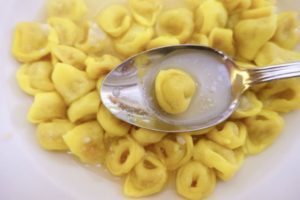
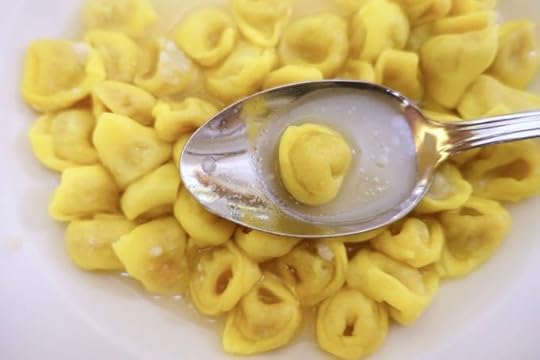
I had always read about how passionate people were about food in Emilia-Romagna. Specifically, while on the train to Modena, I had just finished reading yet another article about one of the most famous chefs in the world, Massimo Bottura, whose Michelin-starred restaurant, Osteria Francescana, is located there. The main theme of the article? About how protective the Modenese are of their nonna’s cooking. Bottura made it sound like this was the most important thing in the world to them. I of course, thought he was probably exaggerating to add bit of drama to a magazine article.
Until, that is, I got in a taxi at the Modena train station and with absolutely no prompting on my part at all the driver began to talk about his nonna’s cooking. It was lunch time, and maybe he was hungry. But he got real specific real fast. Not only were his nonna’s tortellini the best there were, one of the reasons they were so good was because she didn’t use just any Parmigiano, but 30 month old Parmigiano Reggiano. Not 18 month old. Not 36 month old. But specifically 30 month old Parmigiano. “The kind from the red cows,” he specified.
All this and I hadn’t even picked up my rent-a-car yet.
I was on a mission to find out more about tortellini. My reason? Some of it had to do with the romantic story about the origins of this mini dumpling.
According to legend the tiny, belly button shaped, meat filled pasta sprang to life by someone peeping through a keyhole. It may have been an inn keeper in the 15th century in Castelfranco (near Modena) who spied a noblewoman (maybe Lucrezia Borgia) through the keyhole. The beauty of her navel made him run downstairs and recreate it in pasta form. Or it may have been another inn keeper, a couple of centuries earlier, nearer to Bologna, who was spying on Zeus and Venus (who somehow happened to be staying at his Inn). This time is was the beauty of Venus’s belly button that lead to tortellini inspiration.
Whatever its origins, as I began to do research on various types of stuffed pasta, tortellini, and finding the best ones, was at the top of my list. I asked a few people from the area, and even though all of them claimed that their mother produced the best ones, many of them also mentioned a small hotel, or restaurant, just south of Modena. (It turned out that the hotel and restaurant owners were relatives, each making their own version of tortellini)
And that is how I ended up at a small hotel in Settecani in the kitchen with Marisa, who (you will see) revealed her tortellini making magic. At least up to a certain point. While she showed me how she made the stuffing, (the most important part) she wouldn’t share the precise amounts. “A girl has to have some secrets,” she explained. But I was very grateful for the time she allowed me to watch her and her team whip up thousands of tortellini.
While they are always in high production, when I was there two years ago, they were gearing up for the yearly Tortellini Festival in nearby Castelfranco Emilia. Yes, this is the town that, according to legend, gave birth to the first tortellino. This year I made it back there, and not only did I get to gorge myself on tortellini (3 meals worth thank you very much) I was also a guest of the city and got to play dress up with my friend Monica as we participated in the yearly reenactment of infamous tortelllini creation saga. (you can see the one from 2011 when Monica was the Noblewoman and Massimo
Here are a few photos of that day, plus a video I made of Marisa working her magic. Enjoy!!
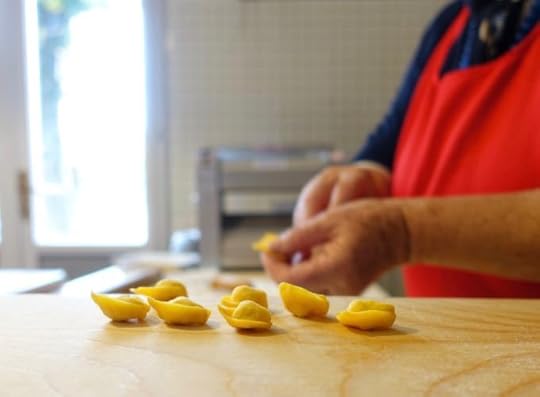
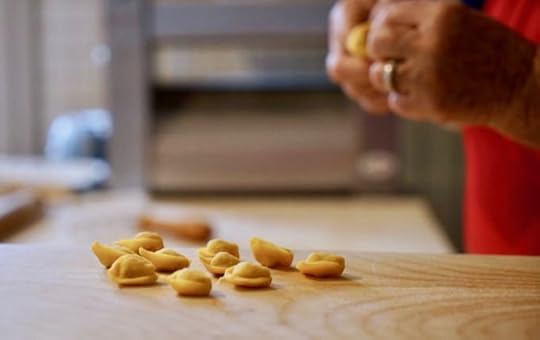
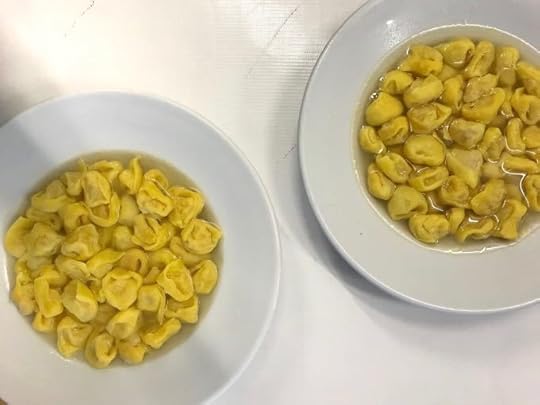

This post is partly and excerpt from my book Eating My Way Through Italy. For more information about tortellini, where to eat them, and for a recipe, please buy my book. And if you are particularly curious about stuffed pasta, there is more from the rich region around Modena and Parma in my next book, The Italian Table.
If you are planning on eating your way through Italy you might also like my app, EAT ITALY, available on iTunes and also for Android.
And if y0u’re TOTALLY dedicated in your pursuit of tortellini, then make sure you attend the next:
Festa del San Nicolo – Sagra dei Tortellini
Castelfranco Emilia, Italy
1st Week of September
This is the tortellini party to end all tortellini parties. It takes place in the supposed birthplace of tortellini, Castelfranco, the first week of September. Expert tortellini makers from all over the area descend to help produce a virtual river of tortellini in brodo, all carefully prepared by hand.
The post making tortellini {video} appeared first on Elizabeth Minchilli.


September 12, 2018
Melissa Clark’s Nose-to-Tail Cooking in Rome
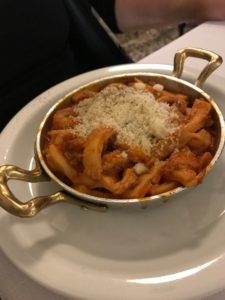
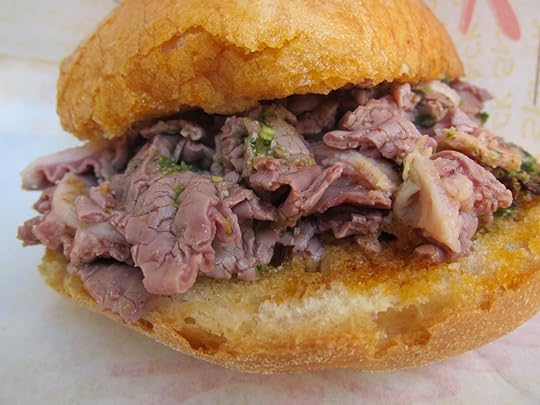
Do you love liver? I do. And I also love tripe, and pancreas and lung and intestines. I even have a hankering for that red thingamajig on top of a rooster’s head. If you are as enamored of these weird and wonderful cuts of meat as I am, then I think we have a special bond. We can definitely be friends.
One the reasons (although there are many) that I can count Melissa Clark as one of my good friends is because we have bonded over things like fried brain, grilled heart and sauteed spleen. Melissa and I have been eating our way around Italy together for almost 20 years. More often than not we would find ourselves on a research or press trip and while other members of the group would be focused on the pasta, pizza and gelato, we would be ordering off the other side of menu to explore liver sausage, nerve salad or pigs feet. If there was a road-side tripe stand, we made the bus stop.
Over the years we have day dreamed about planning an entire week just for us, where we could indulge our inner innard. Now we have. And we’d love it if you could join us.
During Melissa and Elizabeth’s Truly Offal Week in Rome (sorry, but I couldn’t resist) we will have time to dive deep into Rome’s love affair with offal. We will be visiting markets and butchers, and eating at many of our favorite restaurants. We’ll also be spending time in Monti Kitchen, my cooking space, where Melissa and some visiting chefs will be teaching us how to get the best out of the cuts most people throw away.
We will also be heading out of town. We’ll spend a day in Florence, bypassing Michelangelo’s David and Brunelleschi’s Dome on our way to track down the best tripe stands in town. We will also be taking a day trip to Umbria, where we will be breaking down a side of pig to learn how to make porchetta, as well as using the parts most people never dream of eating.
If this week sounds a bit hard core, that’s because it is. This is not the kind of food trip where we can accommodate non-meat eaters. Also? If you are at all squeamish about this kind of stuff (and I realize that many if not most people are) that’s ok. I understand. And I still love you too. But since I love you, I will be perfectly honest and tell you that this week is not for you. I host many other weeks during the year, in Rome, Umbria and Puglia that are a celebration of the side of Italian food where lung is not considered an antipasto. Please join me on one of those.
If, instead, you get excited about learning the differences in tripe recipes between Florence and Rome, or how to make cheese using sheep stomach, then sign on up and join us for this meaty ride.
Details:
When: March 3-9, 2019
Who: Space is limited to 10 guests
Where: We’ll be based in the Monti neighborhood, one of Rome’s most characteristic and charming areas. You will be staying in a private apartment, complete with kitchen, wifi, bedroom and sitting room
What: The days will be full, with adventures both in and out of Rome. But don’t worry, you’ll have some down time as well, to head off on your own to explore.
Some of the things we’ll be doing:
● Welcome dinner at Monti Kitchen cooked by our friend chef Domenico Cortese
● Tour of Testaccio and the 19th century slaughterhouse
● Tastings at the butchers at the Testaccio Market (horse jerky as snack)
● Lunches and dinners in Rome featuring dishes like pajata (lamb intestine); Ox tail; Tripe; Fried brain, etc.
● Day Trip to Florence to visit the city’s Tripe Stands and other specialities
● Day Trip to Umbria to break down a pig
● Food Walk through the Trastevere neighborhood and market
● Cheese making lesson with our friend, Loreto using natural rennet
● Cooking lesson with Melissa, Elizabeth and Sophie
Would you like more information? Just send me an email.
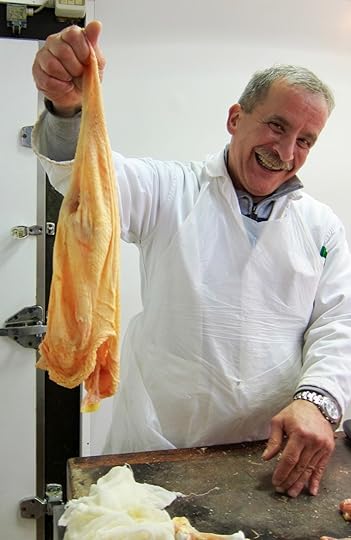

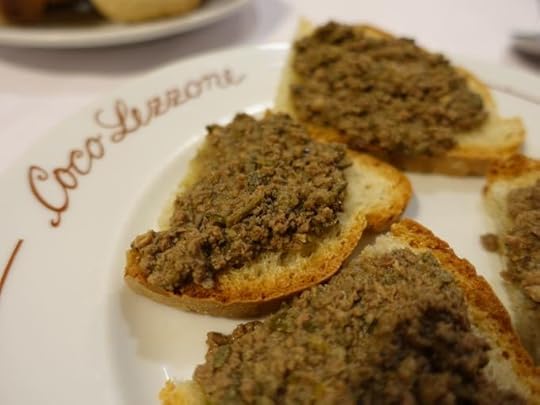
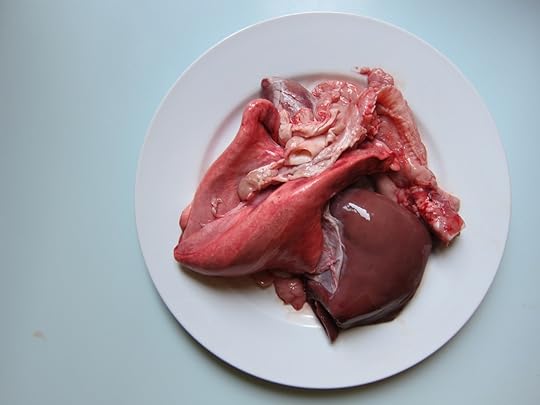
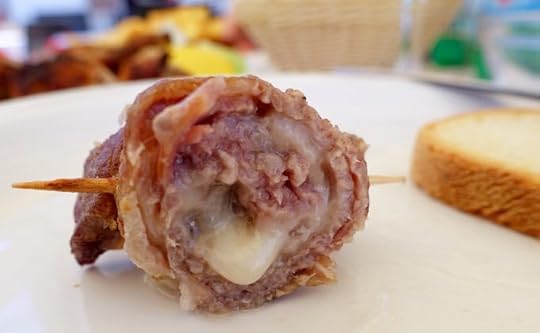
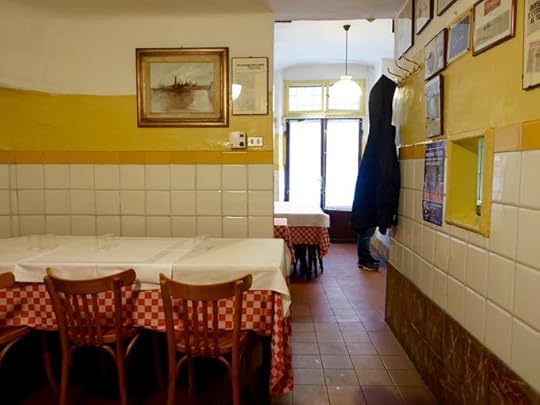
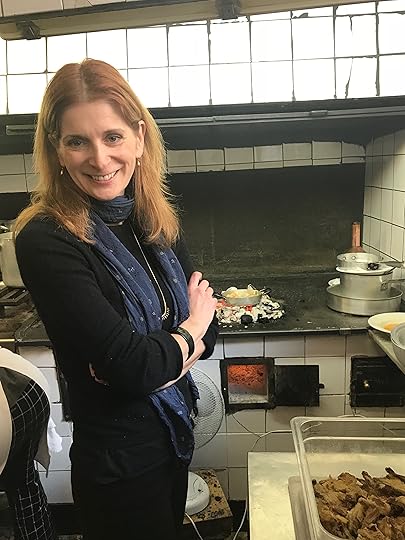
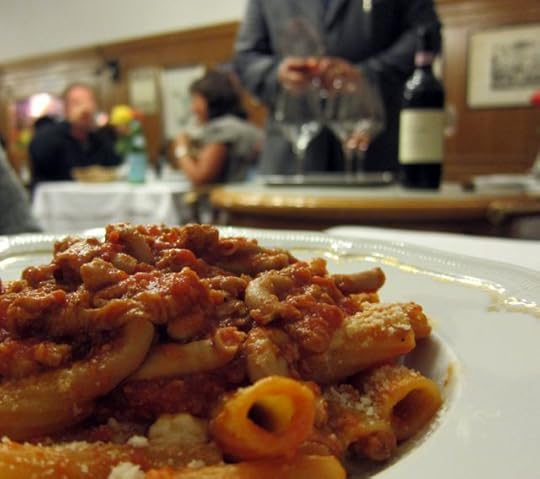
If you’d like to join Melissa, Sophie and me for a truly offal week then just send me an email. If innards or even meat is not your thing, no worries. We have LOTS of ‘normal’ weeks all year long. See this page for descriptions and schedules of our weeks in Rome, Puglia and Umbria for 2019/2020, and then drop me an email if you’d like to know more.
For more information on eating in Rome and the rest of Italy please download my app, EAT ITALY available for iTunes and for Android.
And for more culinary and travel inspiration please buy my books:
The Italian Table: Creating Festive Meals for Families and Friends
The post Melissa Clark’s Nose-to-Tail Cooking in Rome appeared first on Elizabeth Minchilli.


Melissa Clark’s Truly Offal Week
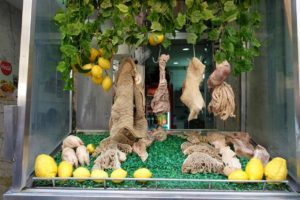
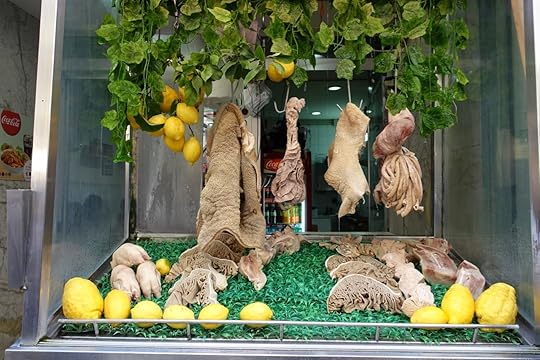
Do you love liver? I do. And I also love tripe, and pancreas and lung and intestines. I even have a hankering for that red thingamajig on top of a rooster’s head. If you are as enamored of these weird and wonderful cuts of meat as I am, then I think we have a special bond. We can definitely be friends.
One the reasons (although there are many) that I can count Melissa Clark as one of my good friends is because we have bonded over things like fried brain, grilled heart and sauteed spleen. Melissa and I have been eating our way around Italy together for almost 20 years. More often than not we would find ourselves on a research or press trip and while other members of the group would be focused on the pasta, pizza and gelato, we would be ordering off the other side of menu to explore liver sausage, nerve salad or pigs feet. If there was a road-side tripe stand, we made the bus stop.
Over the years we have day dreamed about planning an entire week just for us, where we could indulge our inner innard. Now we have. And we’d love it if you could join us.
During Melissa and Elizabeth’s Truly Offal Week in Rome (sorry, but I couldn’t resist) we will have time to dive deep into Rome’s love affair with offal. We will be visiting markets and butchers, and eating at many of our favorite restaurants. We’ll also be spending time in Monti Kitchen, my cooking space, where Melissa and some visiting chefs will be teaching us how to get the best out of the cuts most people throw away.
We will also be heading out of town. We’ll spend a day in Florence, bypassing Michelangelo’s David and Brunelleschi’s Dome on our way to track down the best tripe stands in town. We will also be taking a day trip to Umbria, where we will be breaking down a side of pig to learn how to make porchetta, as well as using the parts most people never dream of eating.
If this week sounds a bit hard core, that’s because it is. This is not the kind of food trip where we can accommodate non-meat eaters. Also? If you are at all squeamish about this kind of stuff (and I realize that many if not most people are) that’s ok. I understand. And I still love you too. But since I love you, I will be perfectly honest and tell you that this week is not for you. I host many other weeks during the year, in Rome, Umbria and Puglia that are a celebration of the side of Italian food where lung is not considered an antipasto. Please join me on one of those.
If, instead, you get excited about learning the differences in tripe recipes between Florence and Rome, or how to make cheese using sheep stomach, then sign on up and join us for this meaty ride.
Details:
When: March 3-9, 2019
Who: Space is limited to 10 guests
Where: We’ll be based in the Monti neighborhood, one of Rome’s most characteristic and charming areas. You will be staying in a private apartment, complete with kitchen, wifi, bedroom and sitting room
What: The days will be full, with adventures both in and out of Rome. But don’t worry, you’ll have some down time as well, to head off on your own to explore.
Some of the things we’ll be doing:
● Welcome dinner at Monti Kitchen cooked by our friend chef Domenico Cortese
● Tour of Testaccio and the 19th century slaughterhouse
● Tastings at the butchers at the Testaccio Market (horse jerky as snack)
● Lunches and dinners in Rome featuring dishes like pajata (lamb intestine); Ox tail; Tripe; Fried brain, etc.
● Day Trip to Florence to visit the city’s Tripe Stands and other specialities
● Day Trip to Umbria to break down a pig
● Food Walk through the Trastevere neighborhood and market
● Cheese making lesson with our friend, Loreto using natural rennet
● Cooking lesson with Melissa, Elizabeth and Sophie
Would you like more information? Just send me an email.








If you’d like to join Melissa, Sophie and me for a truly offal week then just send me an email. If innards or even meat is not your thing, no worries. We have LOTS of ‘normal’ weeks all year long. See this page for descriptions and schedules of our weeks in Rome, Puglia and Umbria for 2019/2020, and then drop me an email if you’d like to know more.
For more information on eating in Rome and the rest of Italy please download my app, EAT ITALY available for iTunes and for Android.
And for more culinary and travel inspiration please buy my books:
The Italian Table: Creating Festive Meals for Families and Friends
The post Melissa Clark’s Truly Offal Week appeared first on Elizabeth Minchilli.


September 6, 2018
bean soup {dinner party}
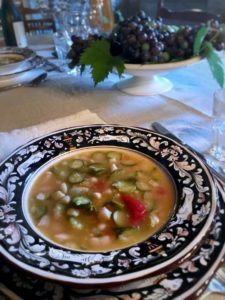
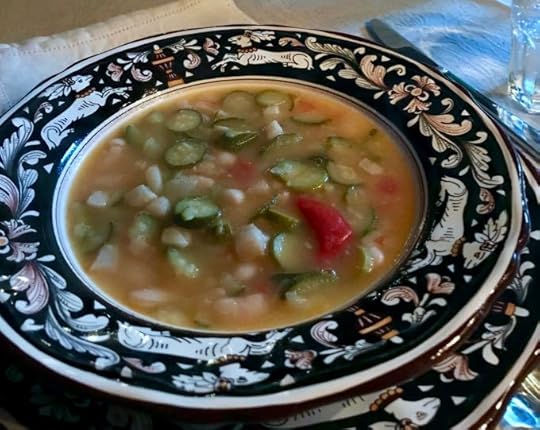
I’m a big believer of the motto that a little bit of meat goes a long way. Is that a motto? If it’s not, it should be. Although I’m by no means a vegetarian, I do believe that a large portion of vegetables or grains paired with a very small portion of meat can make for a great meal. Pancetta is the obvious choice and lends its porky taste to traditional pasta dishes like carbonara and amatriciana. I also like to throw cured meats like prosciutto or salami into salads or even drape them atop veggies before running them under the broiler.
But one of my favorite cuts of meat is one you probably wouldn’t think of using: pork rind. I too was a slow convert. Although I’d eaten my share of cotiche con fagioli in restaurants it wasn’t until last summer, when I was testing my own bean recipe for my next book, that I started cooking with it.
As far as getting the most bang for your meat buck, cotiche is huge. In fact, so far, whenever I’ve gone to my local butcher and asked for cotiche, he’s thrown it in for free. It’s literally a part of the animal that most often gets throw away.
I’m here to tell you that you should be putting it in your soup. The following is a recipe for bean and zucchini soup but you can just as easily put it in your next batch of minestrone. To use pork rind, it has to be blanched first. Once you’ve done that, and cut it into strips or cubes, you can freeze some in a small bag and have it handy to throw into your next pot of soup.
Although you can follow any number of recipes for fagioli con le cotiche that you can find easily online (and I will have one in my next book, The Italian Table) here is my recipe for a soup that is a tad lighter, since it includes zucchini. The magic happens when you add the cotiche which not only adds a depth of porky taste, but the thickens the soup, with its natural gelatin, and makes it silky and even unctuous. It’s even better the next day when the soup has a chance to thicken up over night.
The reason I was cooking up a hearty soup in the middle of what should be a hot summer night is because it was Ferragosto. And like clockwork, every year, on August 15 the weather turns. So rather than have grilled meats under the pergola outside, I decided to set a more formal table and make this soup, as well as one of my favorite hearty main dishes: Marcella’s Pork Chops
Menu
Aperitivi
Truffle studded boar sausage and taralli
Primo
Bean and Zucchini Soup with Cotiche (recipe below)
Secondo
Marcellas Pork Chops with Tomatoes and Sage
Contorno
Baked Eggplants (I made this recipe, minus the tomato topping. Instead I just covered the cooked eggplants with mixed herbs – parsley, mint and basil – that I’d dressed with a bit of olive oil and lemon juice)
Dolce
Watermelon and Alison Roman’s Salted Chocolate Chip Cookies
Setting the Table
Plates: The dishes are the pattern Siena and were made by FIMA in Deruta. I’ve been coveting this pattern for about 20 years, ever since I first saw it while writing my first book on ceramics. While I have other brightly colored dishes I use daily outside in the summer, I save these for special occasions in our dining room.
Tablecloth: The gorgeous linen table cloth I bought at Pardi, which I only managed to stain just a little.
Candelabras: my father calls these my Libarace moment. I think that is because he probably finds them tacky. I find them irresistable which is why I bought them over 25 years ago at a flea market. I LOVE them.
Centerpiece: I love a good raised platter. This fruit dish from Ikea is maybe my favorite. It looks like absolutely nothing on its own (which is the point) but it is exactly the right shape and height for filling with seasonal fruit or vegetables. (I don’t think they make it any more, but in general Ikea is a pretty good resource for anonymous centerpieces to fill up)In this case I walked outside and picked the first clusters of grapes form our vines, as well as a few unripe apples.
What to drink
It was nice enough outside, and had stopped raining long enough that we could sit on the terrace. I opened a bottle of sparkling rose from Madonna del Latte. For our main course full of Umbrian pork only a Sagrantino, from Adanti one of my favorite producers, would do.
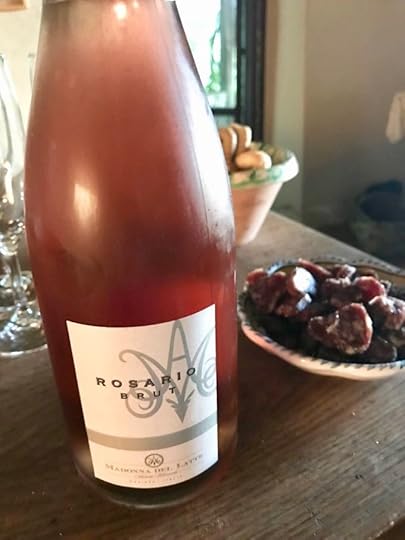
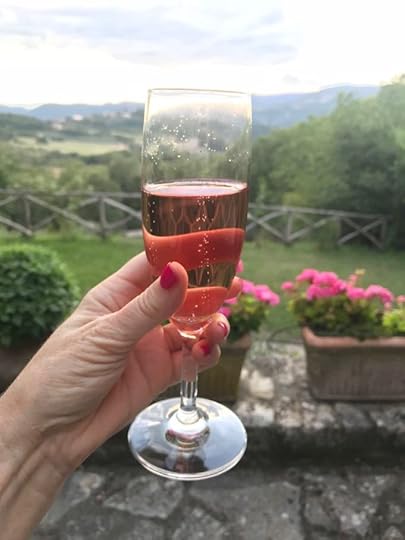
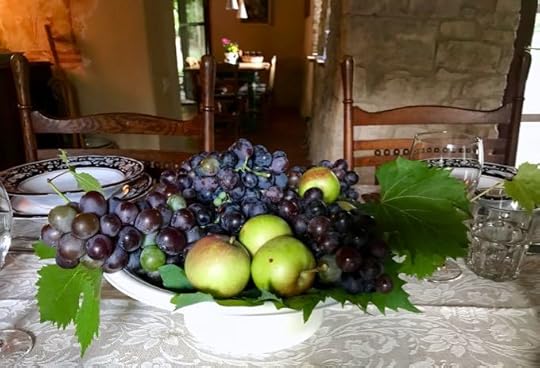
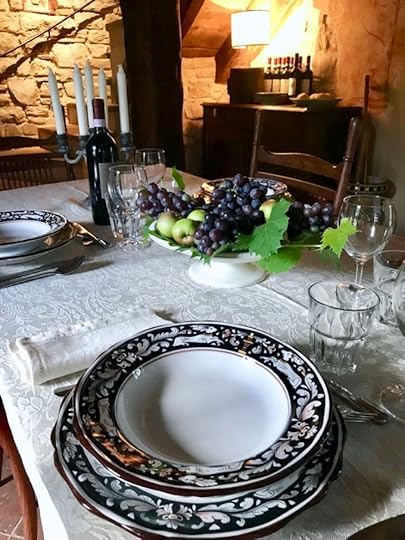
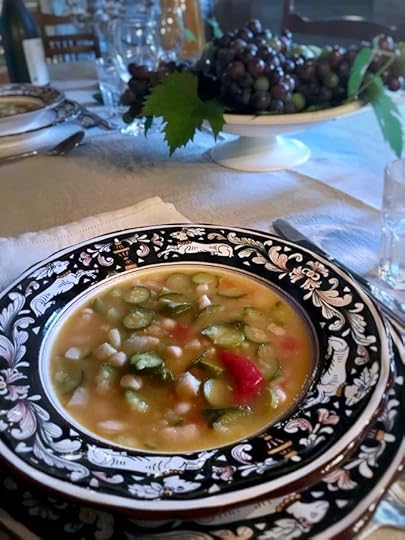
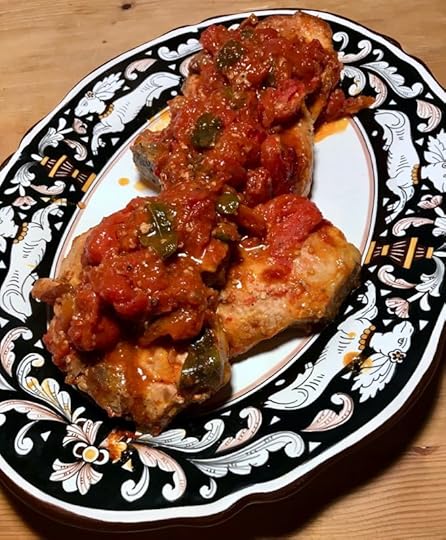
bean soup with zucchini and pork rind
Ingredients
2cups of dried cannellini beans
1 medium onion, peeled and cut in half
2 bay leaves2 teaspoons kosher salt
3 oz of pork rind (cotiche)
1/4 cup of extra virgin olive oil
1 medium onion, diced
2 stalks celery, diced
1 teaspoon salt
1/2 teaspoon or more of red pepper flakes
3 medium zucchini, sliced into 1/4 inch rounds
1 medium tomato, diced
Instructions
Put the beans in a bowl to soak overnight or at least for 6 hours. Drain the beans and place them in a heavy bottomed pot and cover with cool water by 2 inches. Bring to a simmer and remove the foam that floats tot he top. When the foam stops forming add the onion, bay leaves and salt. Simmer, partly covered, until the beans are very tender. (This can take anywhere from 45 minutes to an hour and a half depending on your beans. Let the beans sit in the cooking water until ready to use. If you cook the beans the day before, you can store them in the fridge.
In the meantime bring a small pot of water to boil and add the pork rind. Cook for 20 minutes and then remove to let cool. When it is cool enough to handle chop into small, bite size pieces.
Pour the olive oil into a large, heavy bottomed pot and add the onion, celery, red pepper flakes, pork rind and salt. Cook for about 7 to 10 minutes until the onion and celery are softened. Add the zucchini and cook for another 10 minutes or so. Add the chopped tomatoes, and cook until they break down. Now add the beans and their cooking water.It should be pretty soupy at this point, but if there wasn’t enough liquid from the beans you can add a cup or so of water.
Let the soup simmer for another 45 minutes. At this point I usually use an immersible blender to blend the soup a bit, to thicken up the broth. You don’t want the whole thing to turn into a puree, but more of a chunky thick soup. You can certainly eat it right away, but it’s even better the next day, once the gelatin from the pork rind has a chance to do its magic and thicken it all up.
This soup does not need grated cheese on top, but I do serve it with either red pepper flakes at the table or some sort of hot chili oil which I love.
Hungry for more menus and recipes from Italy? Stay tuned for my upcoming book: The Italian Table: Creating Festive Meals for Family and Friends. It will be published by Rizzoli on March 19, but you can already pre-order it here.
The post bean soup {dinner party} appeared first on Elizabeth Minchilli.


August 27, 2018
the italian table – my new book!!
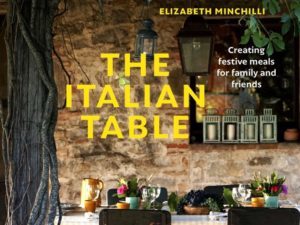
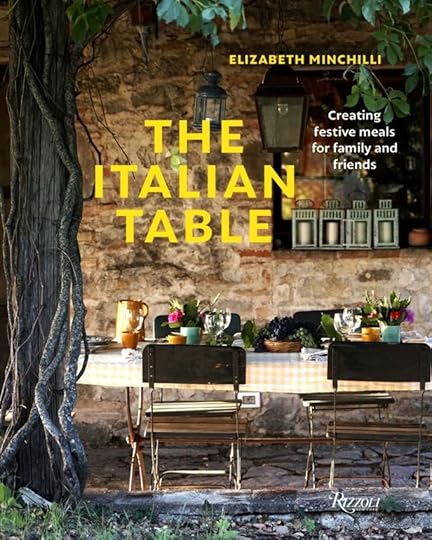
I know it seems like I just wrote a book (I did!) . But if you were paying close attention, there has been a recurring theme in my posts on this blog and on social media. For the last two years I was working on not one, but TWO books at the same time. Call me crazy (don’t worry, I’ve referred to myself that way) but at the time it made sense. Since both books covered a lot of the same physical territory (Italy) and since I was the photographer, as well as the writer, for both projects (again, call me crazy if you feel like it) my thinking was that I might as well kill two birds with one stone while I was on the road and at my desk.
But the story behind my newest book goes back a bit further than Eating My Way Through Italy. In 2013 I was having lunch with an editor from Rizzoli, who I had known for a while. I was just chatting away about Italy while trying not to appear over impressed with that famous roast chicken at Nomad (Remember what a big deal that was in 2013?!) . At one point Chris asked me if I had any ideas for future books (I had just signed a contract to write Eating Rome with another publisher, St. Martins) and somehow, out of my mouth, between bites of chicken, came the words ‘The Italian Dinner Party Handbook’. Not only did it impress me (where had this idea come from?) it also impressed Chris. So much so that I eventually signed a contract for a new book based on not much more than an idea thought up over a mouth full of chicken.
Yes. This is the way publishing often works.
The thing was I had to deliver my other two books first (that’s also how publishing works).
Fast forward five years (and four editors) later and I can now proudly present to you the cover of my next book: The Italian Table: Creating Festive Meals for Family and Friends. Somewhere along the way the title changed (that is also the nature of publishing). But the core concept has remained the same, since that first lunch , and only grown stronger.
Basically this book is my answer to a question I get almost every day:
How do Italians actually eat?
I receive a version of this question on a daily basis. Do Italians really eat three courses at every meal? Do Italians eat pasta every day? How do Italians stay so thin when it seems to be one big carb fest? Does everyone drink wine with every meal?
The answer? Yes. No. Maybe. It depends.
Although there are as many answers as there are questions, my standard response is as beautifully complex as the country is itself. Eating in Italy is as much about the experience as it is about the food. Yes, recipes and ingredients are important, but it is the ceremony of the meal itself – or lack of ceremony in most cases – that so often gets lost once the recipes travel off the peninsula and onto the pages of cookbooks.
Italian food is about experience. The geographic experience, the social experience and the sense of style that most Italians bring to the table.
My new book, The Italian Table, brings all of these elements together, through words and images. It is my portrait of some of the ways that Italians come around the table, and how you can recreate these experiences at home.
And if you’ve been reading my blog over the last year, you’ll kind of get the idea behind my new book. I’ve been posting a lot about creating dinner parties. My main idea behind these posts was to give you a full menu, because that is often the quandary most hosts face when entertaining. And yes, there are pretty pictures, and of course recipes. But there is also advice about entertaining, including setting the table, timing and what to drink. Because for me, these elements are as important as which shape of pasta you choose for your cacio e pepe.
I could go on and on….and I do, in The Italian Table, which will be published by Rizzoli on March 19, 2019. For now, I leave you with the cover. (Which I LOVE. ) And I’ll be sharing much more about it in the coming months.
And although it seems a LONG way off, you can actually pre-order the book already.
The post the italian table – my new book!! appeared first on Elizabeth Minchilli.


August 17, 2018
eating in perugia {umbria}
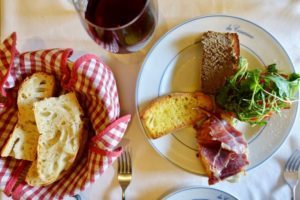
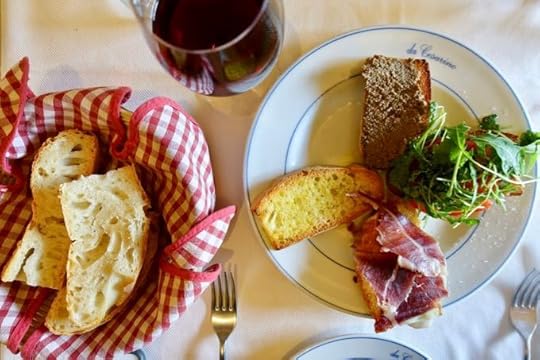
Even though I’ve had a home in Umbria for about 30 years, and have traveled all over this region, the city of Perugia (the capital of Umbria) has always been a no-go zone. And it’s not just me who tends to avoid it. When I ask any of my neighbors here in the countryside (both foreigners as well as Umbrians) everyone has the same response: it’s just too much trouble.
The thing is, Perugia is located on top of a hill. And it’s a big hill and a big town. There are about 160,000 people living there, so it’s definitely the largest city in Umbria. And even though the center is medieval, the surrounding area that has been built up around it is more modern and navigating the roads that lead to it is a puzzle that is difficult to crack. First of all there is the ring road that had tons of tunnels and is a nightmare. Then, once you exit from the ring road and try to follow a map or GPS, the under passes, over passes, roundabouts and forks in the road often mean you miss your turn and have to double back. By the way? This is not just me! It’s anyone you talk to.
And don’t get me started on parking. To visit Perugia you have to find, and then park, in one of 4 or 5 public parking lots. Once there, there are a series of escalators that lead up to the center of town.
But I’m here to tell you that it’s worth the effort. After more or less avoiding Perugia for 30 years, I’ve been up there about 8 times in the past few weeks. And it’s gorgeous. I now have pretty much figured out how to get to my preferred parking lot (Pellini is you want to know) and have figured out the route to get up to the center of town. Which has got to be one of the prettiest walks ever. Medieval buildings and Renaissance palaces are encrusted with carvings and wrought iron details. Buttresses shore up the tipsy foundations forming picturesque archways everywhere you look.
There is also art. Major art. In addition to the Duomo there is the Museum which holds masterpieces by Duccio, Piero della Francesca, Perugino and Fra Angelico, as well as Perugino’s frescoed jewel The Cambio.
The reason that I’ve been spending so much time in Perugia lately, though, is (obviously) because of food. This October I’m leading a week long tour of Umbria with my friend Evan and we will be hosting 30 donors to KCRW, where Evan’s show Good Food is produced. We will be based in Perugia (staying in this very fancy hotel!) and I needed to check out the current restaurant situation to plan out our dinners. Because while during the day we will roam far and wide around Umbria, in the evening who wants to get on another bus? Much better to wander through this gorgeous town and eat a delicious meal.
So for the last two weeks I’ve been enjoying delicious meals. Many many delicious meals. There was even one day when Sophie and I had lunch twice. (the sacrifices I make for work!)
While I’ll be posting fuller descriptions and many more photos in my app Eat Italy in the next week or so, I thought I’d at least post the list of restaurants right away. Just in case you make it up to Perugia. Despite the difficulty. Which you should. Because it’s a pretty fantastic city once you get there.
Osteria a Priori
This tiny restaurant is founded on Slow Food’s principles of using local and seasonal ingredients. The dining room is upstairs and the front of the restaurant is given over to a small shop that sells local legumes, as well as an outstanding selection of local wines, including many that are biodynamic and/or naturally grown. Via dei Priori, 39, 06123 Perugia PG tel: +075 5727 0987
Cantinone
This lovely little restaurant is located just off the main square. The small outdoor terrace faces one of the most stunning archways in town, but locals tend to head for one of the arched inner dinning rooms. I loved loved loved the Umbrian pesto which was made from majoram, thyme, savory and walnuts. Via Ritorta, 06123 Perugia PG +39. 075 573 4430
Al Mangiar Bene
This spacious restaurant is located down a little alleyway (as are most places in the center of Pergugia). The entry way is taken up by a massive wood burning oven that turns out pizzas in the evening, but is used to bake the restaurants bread every morning. Although the menu is not extensive, every item is meticulously sourced. I loved my tagliata (hangar steak) and Sophie ordered a scamorza which had been melted and arrived sizzling at the table in its own little terracotta pot: crusty at the bottom and heaped with truffles on top. Via della Luna, 21, Perugia +39.075 573 1047
Civico 25
This hip and cozy wine bar is a great for either a full meal or just a great glass or bottle of wine and nibbles. Via della Viola, 25, 06122 Perugia PG +39.075 571 6376
Da Cesarino
This is one of the oldest restaurants in Perugia, located right in the main piazza facing the Duomo and the famous fountain. I had read mixed reviews about it online, and realized I needed to try it myself. I skipped the outdoor terrace on a hot and muggy August day and my friend Laura and I headed inside, to the main dining room, with the rest of the locals. And had a pretty fantastic meal. This was not fancy. This was not creative. But a plate full of perfectly made crostini went down well with the house wine. Laura ordered the perfect version of an Umbrian Amatriciana (sausage instead of guanciale) and I had the most amazing stracchino stuffed gnocchi in pesto. Although the waiter started out grumpy (old fashioned restaurant grumpy) by the end he was dragging us into the kitchen to see the open grill. Piazza IV Novembre, 5, 06123 Perugia PG , +39.075 572 8974
Sandri
This turn of the century coffee/pastry shop has recently changed ownership. It’s been spruced up a bit (complete with a lounge area outside which sometimes plays annoying music) but the interiors – and the pastries – have remained unchanged. And they still make the weird almond paste snake shaped pastry that is their specialty. Corso Pietro Vannucci, 32, 06100 Perugia PG
Iper Coop just in case you are the area, this mega supermarket is located in a mall just outside of town. If you’ve rented a villa in the area it’s well worth stopping if only for their amazing wine section. Centro Commerciale Collestrada, Via della Valtiera, 181, 06135 Perugia PG
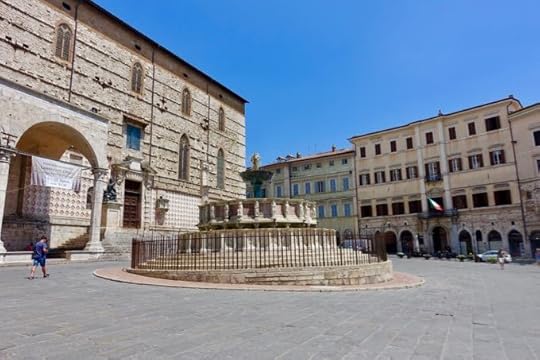
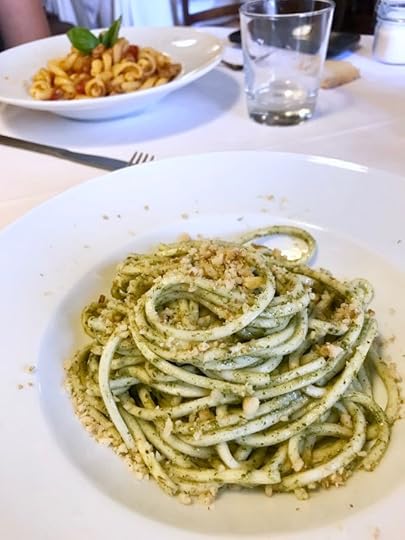
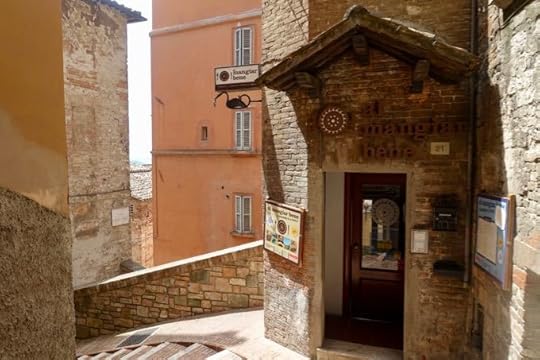
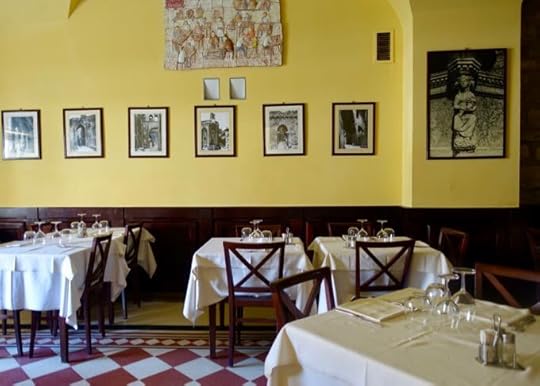
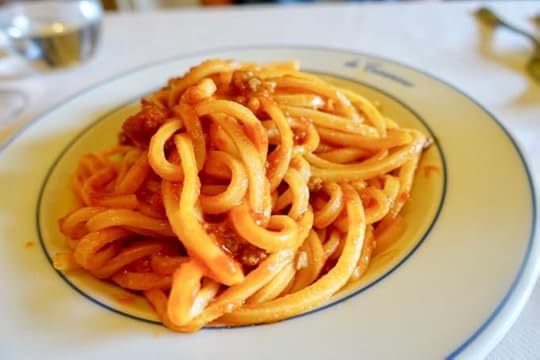
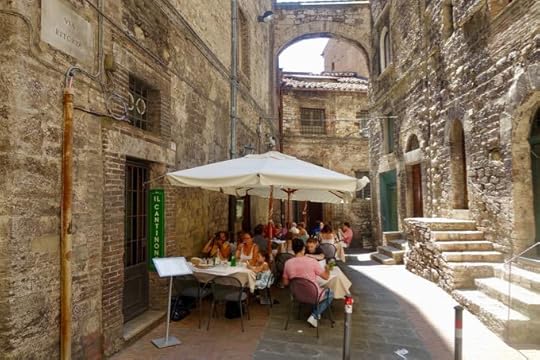
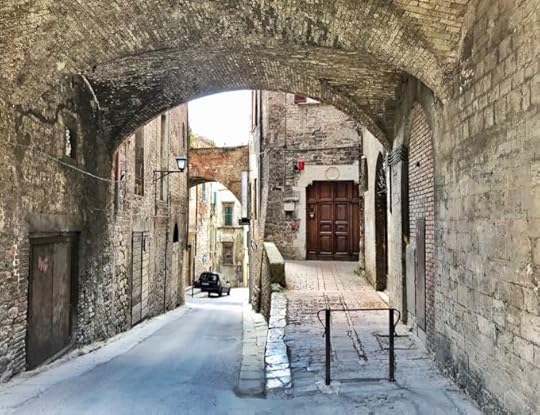
For more information on eating in Umbria and the rest of Italy please download my app, EAT ITALY available for iTunes and for Android.
And for more culinary and travel inspiration please buy my books:
Eating My Way Through Italy
Eating Rome
And if you’d like to join Sophie and me for a Week in Umbria, just send me an email and I”ll send you the details.
The post eating in perugia {umbria} appeared first on Elizabeth Minchilli.





